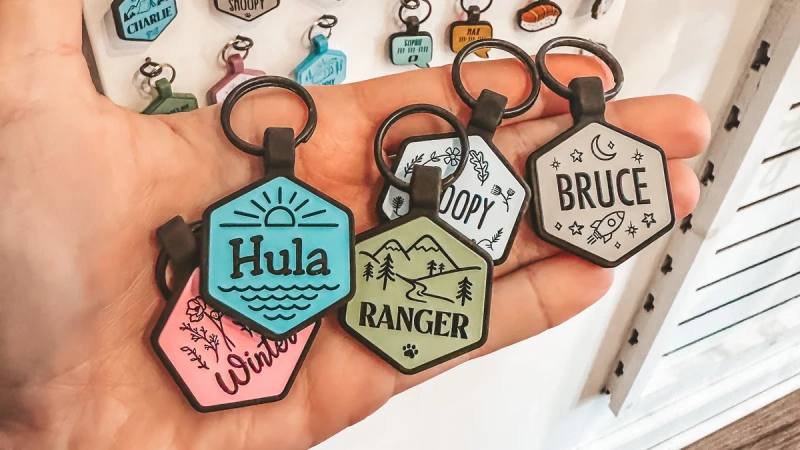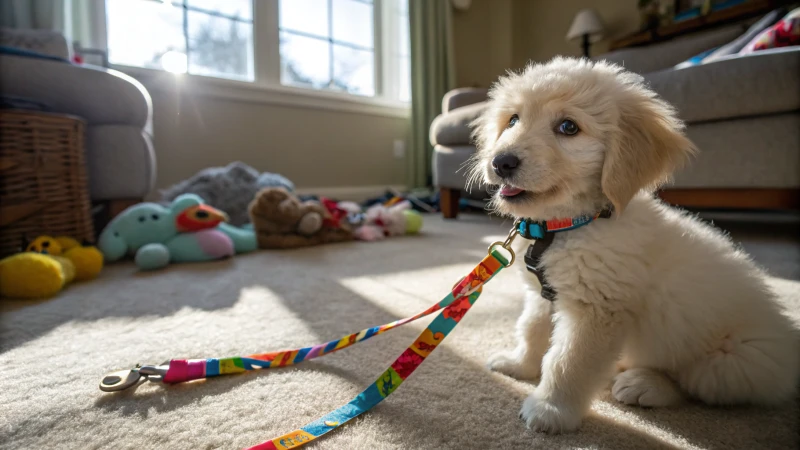
I remember when my puppy first thought her collar was the best chew toy. It was both annoying and cute.
A puppy should use strong collar and leash materials that resist chewing. Puppies really enjoy chew toys as other options. Training with rewards helps. Watch the puppy carefully and slowly teach her not to chew. Monitoring is important. Teaching step-by-step works well to change this habit.
Thinking about that experience helped me understand why puppies chew and how we can stop it. Puppies explore their world with their mouths, just as toddlers use their hands. Chew-resistant materials and fun toys are useful, but understanding deeper strategies helps more. This deeper knowledge matters a lot. Each method helps puppies learn without causing frustration.
Chew-resistant materials stop puppies from chewing leashes.True
Chew-resistant materials are designed to withstand a puppy's chewing habits.
Puppies never chew on collars if given chew toys.False
While chew toys help, they don't completely prevent collar chewing.
What Materials Are Best for Chew-Resistant Leashes?
Has your dog ever happily chewed through another leash again? Don’t worry; I’ve faced this too. I know which materials endure even really determined chewers.
Chew-resistant leashes use strong materials. Chain, cable or reinforced nylon are common choices. These materials are very tough. Dogs usually cannot damage them easily. Pet owners often get tired of buying new leashes all the time. This option provides a lasting answer.
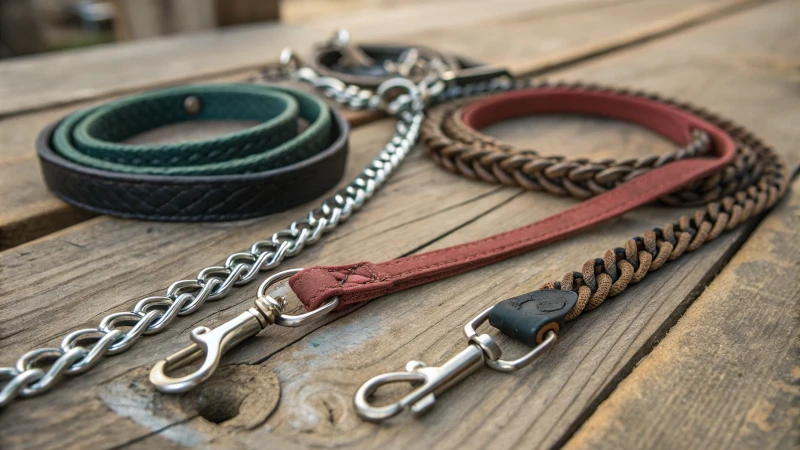
Exploring Chew-Resistant Leash Materials
Choosing the right leash for your playful dog often feels confusing. Let’s explore some strong materials that help many pet owners:
-
Chain Leashes
- Durability: I remember switching to a metal chain leash. It was like finding an umbrella that doesn’t break in strong winds. These leashes stay tough and resist dog bites.
- Considerations: Thick and strong, similar to medieval armor, they feel heavier and less bendable.
-
Cable Leashes
- Durability: Picture steel wires with smooth plastic coating. These leashes mix strength with a bit of give.
- Considerations: Lighter than chains but might not last against persistent chewers.
-
Reinforced Nylon Leashes
- Durability: These leashes are like your favorite jeans—durable yet soft. They resist sharp teeth with tightly woven fabric.
- Considerations: Good balance between strength and comfort. Perfect for daily use.
| Material | Durability Rating | Weight | Flexibility |
|---|---|---|---|
| Chain | ★★★★★ | Heavy | Low |
| Cable | ★★★★☆ | Medium | Medium |
| Reinforced Nylon | ★★★☆☆ | Light | High |
Choosing the Right Material for Your Dog
Selecting a leash depends on your dog’s size and chewing habits. For heavy chewers, a chain leash1 might work best. Worried about weight? Maybe, cable or reinforced nylon offers a good option.
Additional Considerations
- Comfort: Really important for a pleasant walk for both you and your pet.
- Length and Width: Fit this to your dog’s size and usual walk areas.
- Attachment Options: Secure clips that fit your dog’s collar or harness are important.
For more advice on selecting a great leash, look at durable pet products2 gaining popularity.
Chain leashes are the most durable option for chewers.True
Chain leashes are made of metal, offering high durability against chewing.
Reinforced nylon leashes offer no flexibility.False
Reinforced nylon leashes are known for their high flexibility and comfort.
How Can Positive Reinforcement Change Chewing Behavior?
Have you ever felt that your dog’s chewing habits seem impossible to control?
Positive reinforcement helps change a dog’s chewing habits. Reward the dog for picking the right things to chew. Consistent rewards like treats, praise or playtime work well. Give these when the dog chooses a chew toy instead of your shoes. This encourages good habits. This stops destructive chewing. It’s effective!
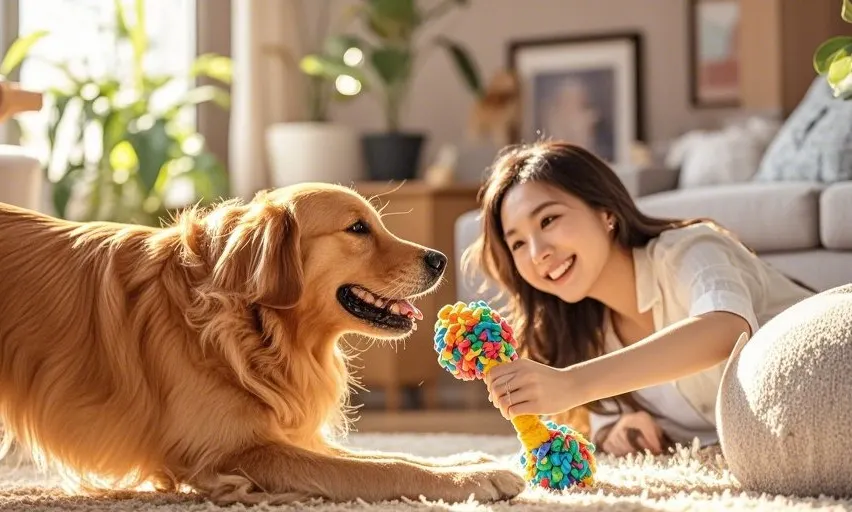
Understanding Positive Reinforcement
I remember when I first learned about positive reinforcement. It felt like finding a magical key that could unlock potential in my dog. Positive reinforcement means giving rewards for behaviors we want to see more. This is a strong tool in managing chewing.
Why Chewing Happens
I saw my dog chewing everything, from shoes to furniture. Chewing is natural for dogs. It helps with teething3, reduces boredom, and even eases anxiety. Knowing why your dog chews is very important for finding answers.
Reinforcement Techniques
-
Reward Good Choices
Each time my dog used his chew toy instead of things he shouldn’t, I gave him a treat or used his favorite praise words. Slowly, he linked his toys with good things. It really worked. -
Timing Matters
Sometimes I missed the right moment. The reward must come right after the good behavior. If I waited too long, my dog got confused and the lesson was lost. -
Teach Commands
Commands like "Leave it" or "Drop it" changed our game. I practiced these often, moving my dog’s focus from things he shouldn’t chew to those he should. -
Slow Introduction
My dog had triggers causing too much chewing. I slowly introduced these in a calm place, with good experiences and rewards. This helped him react less over time.
| Technique | Description |
|---|---|
| Consistent Rewards | Offer rewards every time the desired behavior occurs. |
| Immediate Feedback | Ensure the reward is given right after the behavior. |
Helpful Tools
Tools such as clickers4 in training sessions are helpful. They give quick signals that connect the action with a reward, probably making learning faster.
By using these strategies and truly understanding why your dog might chew, you may guide them to better behaviors over time. Patience and understanding bring great results; my own furry friend improved a lot.
Positive reinforcement can stop dogs from chewing.True
Rewarding dogs for not chewing inappropriate items encourages better behavior.
Delayed rewards improve reinforcement effectiveness.False
Immediate rewards are crucial for reinforcing desired behaviors effectively.
Why Do Puppies Chew on Their Collars and Leashes?
I still remember the first time my small furball chewed on her new leash. It was both cute and a bit worrying. Puppies often have this strange habit of gnawing. What do we do to stop it?
Puppies often gnaw on collars and leashes. Chewing helps them with teething pain, satisfies their curiosity or reduces stress. Chew toys help a lot. Sturdy materials help too. These make a big difference. Good behavior is important.
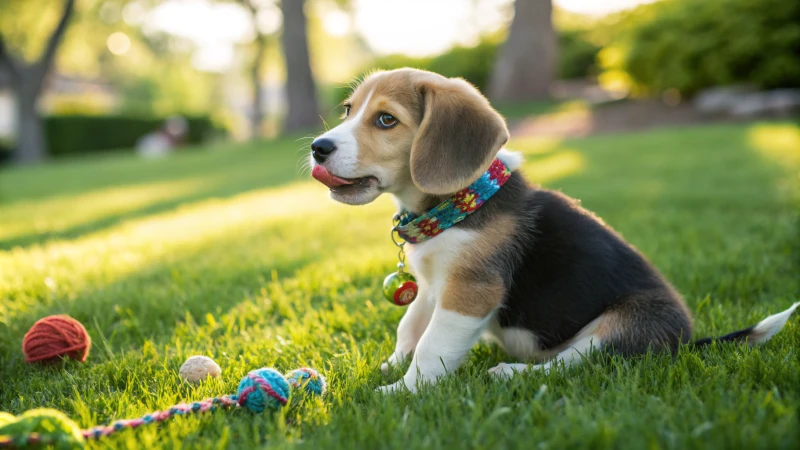
Understanding How Puppies Chew
Puppies act like little explorers. They stay curious and try to understand everything around using their mouths. My puppy found her collar and leash interesting, especially when new teeth were growing. Just like babies chew objects to ease gum pain, puppies do the same.
Stress and Worry
Sometimes chewing isn’t just from teething. When my puppy felt worried or stressed, her leash became an easy target. Recent changes might make them feel uneasy.
| Trigger | Possible Solutions |
|---|---|
| Teething | Offer chew toys designed for teething puppies |
| Anxiety | Use calming aids or increase physical activity |
Choosing the Right Materials
At first, leashes didn’t survive those tiny teeth. Then I found chew-resistant materials like metal chains. It worked wonders! Explore different materials5 that might tempt your pup less.
How to Train
Consistency really helped us. Positive encouragement was very useful. Teaching "Leave it" worked well. Learn more about effective commands6.
- Redirect Attention: When she bit the leash, I gave her a toy or treat to distract her.
- Positive Rewards: Rewards came whenever she didn’t chew.
Offering Different Choices
The right chew toys changed everything for us. They kept her busy and protected her gear. Good chew toys make many puppies happy. Discover top chew toys7 that can keep your puppy occupied.
By learning these behaviors, I dealt with my puppy’s chewing habit effectively, leading to peaceful and joyful walks for both of us.
Puppies chew on leashes due to teething discomfort.True
Teething puppies chew to alleviate gum pain, similar to human babies.
Metal chains are more appealing for puppies to chew.False
Metal chains are less appealing and can deter chewing due to their hardness.
What Are Effective Distraction Techniques for Walks?
Ever wanted a calm walk, but thoughts or discomfort interrupted you? I have experienced that too. But I found some pleasant distractions. They transform a simple walk into pure joy.
Listening to audiobooks during walks distracts effectively. Observing surroundings with attention helps shift focus. Breathing with rhythm brings calm and delight. These methods transform discomfort into joy and enrich walks.

Listen to Audiobooks or Podcasts
Listening to audiobooks or podcasts can transform a walk into an engaging experience. With headphones in, I dive into a good story or insightful discussion. Mystery novels are favorites as they keep me guessing, while self-help podcasts inspire me. This auditory experience makes a normal walk special.
| Audio Choices | Description |
|---|---|
| Audiobooks | Choose captivating stories or topics that pique your interest. |
| Podcasts | Explore various genres like true crime, comedy, or technology insights. |
For a list of popular audiobooks8, start with your favorite genres.
Observe Mindfully
Mindful observation has really changed things for me. It involves noticing the world around me—the sunlight through leaves, the birds singing. When my mind wanders to stress, I focus back on simple joys.
To practice effectively:
- Sense Focus: What can you see, hear, feel, and smell?
- Be Present: Gently bring your attention back if distracted.
- Appreciate Details: Notice small things like patterns on leaves or cloud shapes.
Learn more about mindful observation techniques9 to improve your walks.
Try Rhythmic Breathing
I’ve found that rhythmic breathing calms and energizes me. Aligning breath with steps connects me to the walk’s rhythm and helps discover my pace.
Here’s how you can try it:
- Inhale: Count "1, 2" as you breathe in through your nose.
- Exhale: Count "1, 2, 3" as you breathe out through your mouth.
- Continue: Adjust counts for comfort.
This method not only serves as a distraction but also enhances physical endurance by promoting oxygen flow. Find more about rhythmic breathing10 in walker-specific guides.
Walking now nurtures both body and mind. Exploring these techniques helps me find what works best for me.
Audiobooks can transform walks into learning journeys.True
Listening to audiobooks engages the mind, making walks educational.
Rhythmic breathing decreases physical endurance while walking.False
Rhythmic breathing actually enhances physical endurance by improving oxygen flow.
Conclusion
To prevent puppies from chewing their collars and leashes, use chew-resistant materials, provide alternatives like toys, and employ positive reinforcement training techniques for effective behavior management.
-
Learn why chain leashes are effective against aggressive chewers. ↩
-
Find durable pet products that withstand wear and tear. ↩
-
This link offers insights into the reasons behind chewing behavior in dogs, helping you address underlying causes effectively. ↩
-
Clickers can be a powerful tool in dog training, providing immediate feedback that aids learning and behavior correction. ↩
-
Explore materials that deter chewing effectively, protecting your investment in pet accessories. ↩
-
Find out how specific commands can redirect your puppy’s attention from unwanted behaviors. ↩
-
Discover durable chew toys that help soothe teething discomfort and keep your puppy engaged. ↩
-
Discover new audiobooks that keep you engaged during walks, turning mundane strolls into enriching experiences. ↩
-
Learn how to practice mindfulness effectively on walks, enhancing awareness and presence. ↩
-
Find detailed instructions on rhythmic breathing to improve your walking routine and mental focus. ↩


